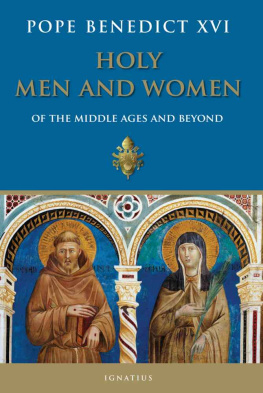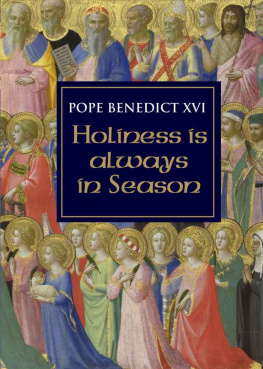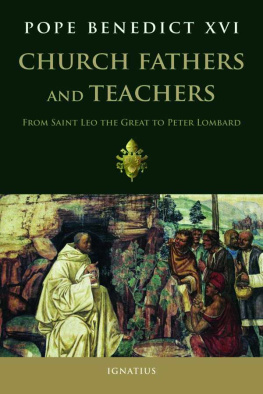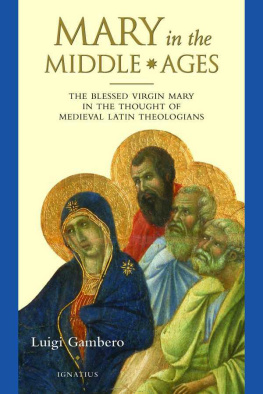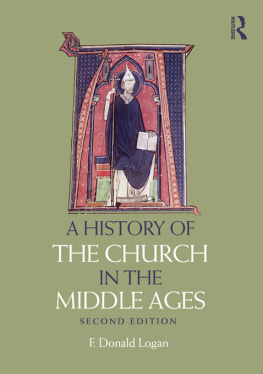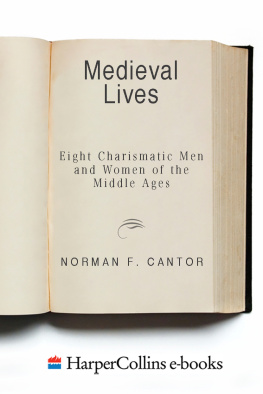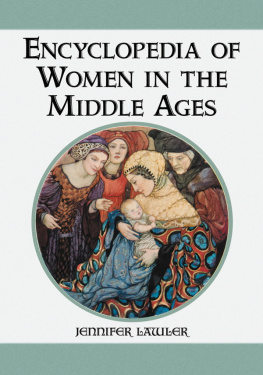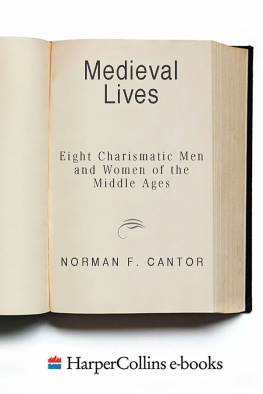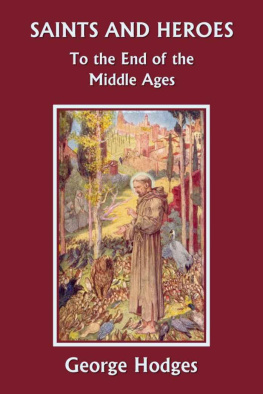HOLY MEN AND WOMEN
OF THE MIDDLE AGES AND BEYOND
POPE BENEDICT XVI
HOLY MEN AND
WOMEN OF THE
MIDDLE AGES
AND BEYOND
General Audiences
13 January 2010-26 January 2011
IGNATIUS PRESS SAN FRANCISCO
English translation by LOsservatore Romano
Cover art:
Saint Francis and Saint Clare
By Giotto di Bondone (1266-1336)
Upper Church, S. Francesco, Assisi, Italy
Alinari / Art Resource, New York
Papal coat of arms image by www.AgnusImages.com
Cover design by Roxanne Mei Lum
2012 by Libreria Editrice Vaticana, Vatican City
All rights reserved
ISBN 978-1-58617-620-4
Library of Congress Control Number 2011924508
Printed in the United States of America
CONTENTS
1
The Mendicant Orders
WEDNESDAY, 13 JANUARY 2010
Paul VI Audience Hall
Dear Brothers and Sisters ,
At the beginning of the New Year, let us look at the history of Christianity to see how history develops and how it can be renewed. It shows that saints, guided by Gods light, are the authentic reformers of the life of the Church and of society. As teachers with their words and witnesses with their example, they can encourage a stable and profound ecclesial renewal because they themselves are profoundly renewed, they are in touch with the real newness: Gods presence in the world. This comforting reality, namely, that in every generation saints are born and bring the creativity of renewal, constantly accompanies the Churchs history in the midst of the sorrows and negative aspects she encounters on her path. Indeed, century after century, we also see the birth of forces of reform and renewal, because Gods newness is inexhaustible and provides ever new strength to forge ahead. This also happened in the thirteenth century with the birth and the extraordinary development of the Mendicant Orders: an important model of renewal in a new historical epoch. They were given this name because of their characteristic feature of begging, in other words, humbly turning to the people for financial support in order to live their vow of poverty and carry out their evangelizing mission. The best known and most important of the Mendicant Orders that came into being in this period are the Friars Minor and the Friars Preachers, known as Franciscans and Dominicans. Thus they are called by the names of their Founders, Francis of Assisi and Dominic de Guzman, respectively. These two great saints were able to read the signs of the times intelligently, perceiving the challenges that the Church of their time would be obliged to face.
A first challenge was the expansion of various groups and movements of the faithful who, in spite of being inspired by a legitimate desire for authentic Christian life, often set themselves outside ecclesial communion. They were profoundly averse to the rich and beautiful Church which had developed precisely with the flourishing of monasticism. In recent Catecheses I have reflected on the monastic community of Cluny, which had always attracted young people, therefore vital forces, as well as property and riches. Thus, at the first stage, logically, a Church developed whose wealth was in property and also in buildings. The idea that Christ came down to earth poor and that the true Church must be the very Church of the poor clashed with this Church. The desire for true Christian authenticity was thus in contrast to the reality of the empirical Church. These were the so-called paupers movements of the Middle Ages. They fiercely contested the way of life of the priests and monks of the time, accused of betraying the Gospel and of not practicing poverty like the early Christians, and these movements countered the Bishops ministry with their own parallel hierarchy. Furthermore, to justify their decisions, they disseminated doctrine incompatible with the Catholic faith. For example, the Cathars or Albigensians movement reproposed ancient heresies such as the debasement of and contempt for the material worldthe opposition to wealth soon became opposition to material reality as suchthe denial of free will, and, subsequently, dualism, the existence of a second principle of evil equivalent to God. These movements gained ground, especially in France and Italy, not only because of their solid organization, but also because they were denouncing a real disorder in the Church, caused by the far from exemplary behavior of some members of the clergy.
Both Franciscans and Dominicans, following in their Founders footsteps, showed, on the contrary, that it was possible to live evangelical poverty, the truth of the Gospel as such, without being separated from the Church. They showed that the Church remains the true, authentic home of the Gospel and of Scripture. Indeed, Dominic and Francis drew the power of their witness precisely from close communion with the Church and the Papacy. With an entirely original decision in the history of consecrated life, the Members of these Orders not only gave up their personal possessions, as monks had done since antiquity, but even did not want their land or goods to be made over to their communities. By so doing they meant to bear witness to an extremely modest life, to show solidarity to the poor, and to trust in Providence alone, to live by Providence every day, trustingly placing themselves in Gods hands. This personal and community style of the Mendicant Orders, together with total adherence to the teaching and authority of the Church, was deeply appreciated by the Pontiffs of the time, such as Innocent III and Honorius III, who gave their full support to the new ecclesial experiences, recognizing in them the voice of the Spirit. And results were not lacking: the groups of paupers that had separated from the Church returned to ecclesial communion or were gradually reduced until they disappeared. Today too, although we live in a society in which having often prevails over being, we are very sensitive to the examples of poverty and solidarity that believers offer by their courageous decisions. Today too, similar projects are not lacking: the movements, which truly stem from the newness of the Gospel and live it with radicalism in this day and age, placing themselves in Gods hands to serve their neighbor. As Paul VI recalled in Evangelii Nuntiandi , the world listens willingly to teachers when they are also witnesses. This is a lesson never to be forgotten in the task of spreading the Gospel: to be a mirror reflecting divine love, one must first live what one proclaims.
The Franciscans and Dominicans were not only witnesses but also teachers. In fact, another widespread need in their time was for religious instruction. Many of the lay faithful who dwelled in the rapidly expanding cities wanted to live an intensely spiritual Christian life. They therefore sought to deepen their knowledge of the faith and to be guided in the demanding but exciting path of holiness. The Mendicant Orders were felicitously able to meet this need, too: the proclamation of the Gospel in simplicity and with its depth and grandeur was an aim, perhaps the principal aim, of this movement. Indeed, they devoted themselves with great zeal to preaching. Great throngs of the faithful, often true and proper crowds, would gather to listen to the preachers in the churches and in the open air; let us think, for example, of Saint Anthony. The preachers addressed topics close to peoples lives, especially the practice of the theological and moral virtues, with practical examples that were easy to understand. They also taught ways to cultivate a life of prayer and devotion. For example, the Franciscans spread far and wide the devotion to the humanity of Christ, with the commitment to imitate the Lord. Thus it is hardly surprising that many of the faithful, men and women, chose to be accompanied on their Christian journey by Franciscan or Dominican Friars, who were much sought after and esteemed spiritual directors and confessors. In this way associations of lay faithful came into being, which drew inspiration from the spirituality of Saint Francis and Saint Dominic as it was adapted to their way of living. In other words, the proposal of a lay holiness won many people over. As the Second Ecumenical Vatican Council recalled, the call to holiness is not reserved to the few but is universal (cf. Lumen Gentium , no. 40). In all the states of life, in accordance with the demands of each one of them, a possibility of living the Gospel may be found. In our day, too, each and every Christian must strive for the high standard of Christian living, whatever the class to which he belongs!
Next page
